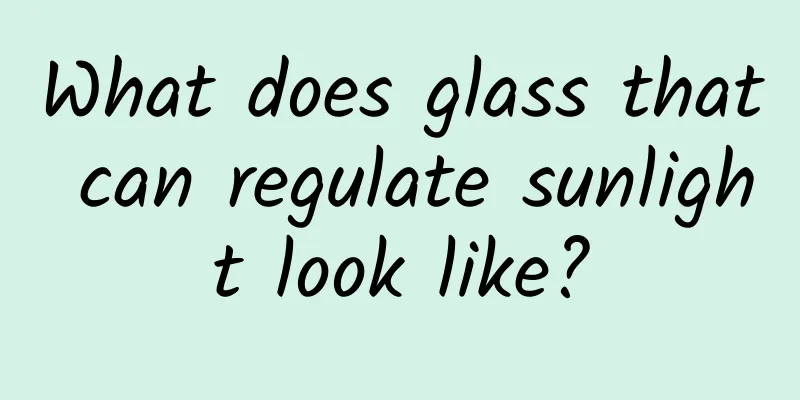What does glass that can regulate sunlight look like?

|
Produced by: Science Popularization China Produced by: Chen Lin (Institute of Engineering Thermophysics, Chinese Academy of Sciences), Chen Jintao (Beijing University of Aeronautics and Astronautics) Producer: Computer Network Information Center, Chinese Academy of Sciences Glass has been in our human society for thousands of years, but for a long time, glass was actually a luxury item, almost on the same level as gold and silver jewelry. For example, Jia Rong in "Dream of Red Mansions" once asked Wang Xifeng to borrow a glass screen to show off his wealth and show that he was a member of the upper class. In the early 20th century, due to breakthroughs in production technology, glass began to gradually enter the homes of ordinary people. The most notable feature of glass is its strong light transmittance, which allows people to enjoy the sunshine in the house while seeing the scenery outside. Night inside the window (Photo source: veer Gallery) However, this characteristic of glass also has disadvantages. In summer, sunlight shines into the room through the glass, raising the temperature of the room; in winter, a large amount of heat is lost through the glass, causing the temperature inside the house to drop. Current research shows that the energy loss through doors and windows in my country has accounted for about one-fifth of our total social energy consumption. This is a very shocking figure, and we rarely pay attention to it. So, how does glass waste energy? The reason why glass wastes energy: thermal radiation According to the basic principles of thermodynamics, we know that there are three main forms of heat transfer: heat convection, heat conduction and heat radiation. Thermal convection refers to the phenomenon that heat is transferred due to the flow of gas or liquid. For example, if you have a window and close it, you can block the air convection between indoor and outdoor, thereby reducing energy consumption. Heat conduction means that heat will be transferred from a higher temperature area to a lower temperature area. From the perspective of heat conduction, to obtain glass with good energy-saving effect, we can make the glass thicker, or make the glass into two layers, leaving a hollow space between the two layers, or even further, evacuate the hollow area, which is the common double-layer glass now. Thermal radiation refers to the phenomenon that an object radiates electromagnetic waves due to its temperature. From this perspective, the situation is a little more complicated. The purpose of installing glass is to see the outside world. At the same time, the room will receive radiation from the sun through the glass to increase the internal temperature, while the indoor heater will radiate electromagnetic waves outward through the glass, causing the room temperature to drop. So, a truly good energy-saving glass is one that allows solar radiation to enter, but does not allow radiation that raises the room temperature to escape easily, thus controlling all radiation. However, a large amount of heat radiation overflow is the key way that glass wastes energy. Three forms of heat transfer (Image source: Reference 3) For example, in winter, the sources of indoor heat are mainly solar radiation and heater radiation. Solar radiation will enter the room through the glass, and the indoor temperature is usually higher than the outdoor temperature. In addition, various heating devices such as radiators and heaters will emit medium and long infrared radiation at room temperature. The radiation hits the glass, causing the glass to absorb the radiated heat and heat up. Subsequently, the glass will transfer this part of energy to the ice and snow outside, resulting in a large amount of energy loss. If we can find a way to allow more solar radiation to come in and less heating radiation to go out, then we can greatly reduce this type of energy consumption. Different radiation passing through ordinary glass (Image source: Reference 1) Now, scientists have developed a new material. When applied to glass, it has the ability to regulate sunlight, turning it into a new type of energy-saving glass. So, what is this new material? How does it make glass energy-efficient? What are its advantages over traditional energy-saving glass? Let me tell you slowly. Metamaterials for regulating thermal radiation have been successfully developed The biggest difference between solar heat radiation and indoor heat radiation is that they are in different wavelengths. Therefore, if we set the entry and exit conditions of the wavelengths on the glass, we can artificially control their presence or absence. Based on this idea, researchers from the Institute of Engineering Thermophysics of the Chinese Academy of Sciences combined highly transparent polymer materials with nano-component units with specific structures to design a metamaterial (an artificial material with special properties) that can regulate radiation. By applying this artificial material on ordinary glass, it can be transformed into a new type of energy-saving glass. The wavelengths of solar thermal radiation and indoor thermal radiation (Image source: Reference 1) In this metamaterial, highly transparent polymer materials allow visible light to pass through better, while nano-units are responsible for screening radiation - when encountering short-wavelength solar radiation, it will be activated and release energy; and for the long-wavelength thermal radiation emitted by room-temperature objects, it will form a "big net" to reflect it back. This metamaterial combined with glass can allow the glass to selectively pass heat radiation while maintaining good light transmittance, thereby achieving the purpose of keeping warm in winter and blocking heat in summer. Metamaterials absorb solar heat radiation and prevent indoor heat radiation from escaping (Image source: Reference 1) How effective is the new glass in energy saving? Researchers conducted an experiment: two glass room models, one made of ordinary glass and the other made of high-efficiency energy-saving glass. The initial temperature in both models was 21 degrees Celsius, and the simulated sunlight irradiation equipment was turned on to allow them to receive direct sunlight at the same time. The experimental results showed that after one hour, the temperature of the ordinary glass room rose to 27.3 degrees Celsius, and the temperature of the high-efficiency energy-saving glass room rose to 43 degrees Celsius. Temperature comparison test between radiation controlled glass room and ordinary glass room (Image source: Reference 1) Compared with the initial temperature, the temperature of the two model rooms increased by 6.3 degrees Celsius and 22 degrees Celsius respectively. In other words, the energy-efficient glass room increased by 15.7 degrees Celsius more than the ordinary glass room. Temperature rise results of radiation-controlled glass room and ordinary glass room experiments (Image source: Reference 1) This shows that high-efficiency energy-saving glass has a better transmittance of solar thermal radiation, and also has a better blocking effect on the spillover of indoor thermal radiation. Experiments have shown that high-efficiency energy-saving glass can help us better utilize solar energy and also help us better save energy. What are the advantages of energy-efficient glass? Compared with the existing energy-saving glass, the new energy-saving glass has three main advantages: The first is high efficiency. The use of new energy-saving glass can ensure indoor energy saving while allowing as much solar energy as possible to enter, thus having a better effect on indoor temperature control. Surveys show that the visible light transmittance of existing energy-saving glass is relatively low, generally 30% to 70%, but new energy-saving glass can reach more than 85%, allowing more light to come in. The second advantage is the convenience in production, transportation and use. The production of conventional energy-saving glass requires the evaporation of various coatings in a vacuum, which will result in high production costs and inconvenient transportation. In addition, because the inside of conventional energy-saving glass is vacuum, the entire glass needs to be replaced for replacement. As for the new energy-saving glass, whether it is traditional glass or glass with certain energy-saving performance, as long as it has been formed, there is no need to dismantle it or make other changes. It only needs to be coated with this material or a film made of this material can be used. The third advantage is flexibility. This metamaterial is a flexible material that can be applied in different scenarios. For example, in the past, it was difficult to apply low-emissivity glass to tents because low-emissivity glass requires a double layer of thick glass to protect the functional layer inside, which lacks flexibility. Now, with this new technology, we can make metamaterials into films or directly make them into coatings and spray them on tents. Although energy-efficient glass performs well in the laboratory, its universal applicability remains to be verified because more extensive environmental resistance tests, such as those in extremely cold regions and areas with strong salt fog, have not yet been carried out. Before a new technology is applied to life, it needs to be subject to rigorous scientific research and analysis. But this does not prevent us from looking forward to the future application of this technology, because its own characteristics can bring us unlimited longing. What are the application prospects of high-efficiency energy-saving glass? The flexibility of energy-efficient glass has allowed scientists to see numerous application prospects. For example, we need to grow off-season vegetables in agricultural greenhouses, but in some areas, due to the high overall latitude, insufficient sunlight, and low temperature in the greenhouse, the planting effect is not ideal. If this metamaterial is applied to the greenhouse, it can increase and maintain the temperature inside the greenhouse, which is equivalent to an enhanced "plastic greenhouse 2.0". Some scientists even have wild ideas, thinking that if humans can grow vegetables on Mars in the future, they might be able to use this metamaterial to better utilize solar energy. Vegetable greenhouse (Image source: Reference 4) For example, this metamaterial can also be used to enhance the heat preservation of boxes. In the future, transparent boxes with metamaterial coatings and better heat preservation may allow us to taste more delicious food and help delivery boys. Energy-efficient glass can also provide more technical imagination. Its core is actually to selectively pass light radiation. If scientists can selectively pass light, then can they also selectively pass electromagnetic waves within the light range? Sometimes our mobile phone signals are not very good indoors because the electromagnetic waves from the base station outside the house cannot reach the house. If we can update and upgrade the current technology, can we selectively obtain the desired electromagnetic waves and eliminate the interference of other clutter? Even more, can we block electromagnetic waves that are harmful to the human body from entering the room? Perhaps in the near future, scientists will be able to successfully solve the problem and lead us to a glimpse of the truth. References: 1. "Seeing through new technologies" 20210417 Glass that regulates sunlight_CCTV program official website-CCTV-10_CCTV.com (cctv.com) 2. Beijing urban scenery outside the glass window picture material_ID:VCG211129496296-VCG.COM 3. Definition and difference of heat conduction, heat convection and heat radiation_Baidu Knows (baidu.com) 4. How to solve the problem of planting light in modern vegetable greenhouse construction (11467.com) 5. Food delivery is so hard, why are so many people still rushing to do it? _Income (sohu.com) |
<<: Why does my conjunctivitis recur when winter comes?
>>: Behind the debut of Dinosaur Star, there are 19 fractures
Recommend
6 tips for writing Facebook ad copy with high click-through rates!
A successful Facebook ad is inseparable from eye-...
Ace School Prince Comics Collection: What aspects should new sites avoid when doing SEO?
The new website has just been launched, so you ca...
Movie Paradise v1.0 Ad-free Upgraded Version_Green Software Network
Software Information Name: Movie Paradise Package...
Starting from Google, let’s talk about future product design trends
The author of this article analyzed many aspects ...
These tricks to pick up girls are also very suitable for writing advertising copy
What you are flirting with girls is actually thei...
Xiaohongshu | A practical guide to high ROI precision delivery
Let us first take a look at the latest signal rel...
How much does it cost to customize the Zaozhuang coupon mini program? Zaozhuang coupon applet customized price inquiry
How much does it cost to customize the Zaozhuang ...
Practical tips: How to increase followers on Douyin?
Recently, some people have been asking, “Why is T...
What are the most cost-effective APP promotion methods?
This topic is not my best, because most of my pre...
After the crash of B Station, A Station also crashed! Official response: It has been fixed
On the evening of July 13, the Weibo topic "...
Can drinking alcohol prevent kidney disease? Let’s learn about these hazards first! Friends who love drinking should not miss it!
gossip It is well known that "drinking alcoh...
Sony WH-H800 headphones' best companion NW-A45 player will be your new choice for pursuing good sound quality
Although more and more smartphones are now adding...
The new media red ocean is approaching. How can corporate new media make a second breakthrough in 2017?
It is standard for companies to have new media ac...
APP operation: How to efficiently recall users and achieve an ROI of more than 500%?
Many people are using recall campaigns to retain ...
Romantic attraction or fatal temptation? Who are the night lights affecting subtly?
Artificial light at night can change the behavior...









